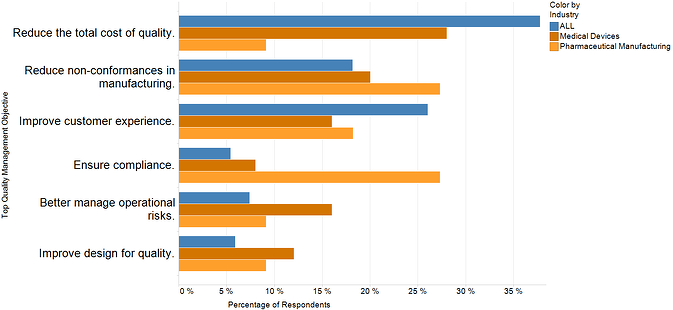 It’s the nature of a manufacturing business to have both competing and complementary goals and objectives. Financial and operational goals are sometimes seemingly at odds where time and resource investments should be made to best meet overall corporate initiatives. But sometimes, there exist opportunities for alignment and synergy as well.
It’s the nature of a manufacturing business to have both competing and complementary goals and objectives. Financial and operational goals are sometimes seemingly at odds where time and resource investments should be made to best meet overall corporate initiatives. But sometimes, there exist opportunities for alignment and synergy as well.
Such is the case with life sciences companies, particularly in small to medium sized businesses (SMBs) today. In an industry that is both highly competitive and highly burdened with governmental regulations, the goals of getting more products to market on-time while experiencing fewer non-conformances jibe well with the universal SMB goal of voracious revenue growth.
And there are new technology and process capabilities around product quality that are helping companies address this challenge, specifically, the closed-loop quality architecture facilitated by Enterprise Quality Management Software (EQMS) applications. In this post, we’ll detail more about SMB life sciences challenges, and how EQMS solutions are helping companies better meet regulatory requirements, get products to market faster, and ultimately, add to the top line.
The Drive for Revenue Growth in Life Sciences SMBs
While every company is focused on revenue growth as an important priority, in the highly competitive life sciences SMBs it is a particularly notable objective. Looking at data from our 2013-2014 Quality Management survey, while growing revenue was the top objective for all SMB companies, it was significantly higher among those SMBs in the life sciences industries, as 71% vs. 53% of respondents selected this as a top financial objective in life sciences vs. all other industries.
Additionally, when we look at industry-segmented top quality management objectives, we also see some disparity between the goals of life sciences companies vs. other industries at large. While industries across the board are focused on reducing the total cost of quality, within life sciences companies we see a different picture emerge. As the graph shows below, the reduction of manufacturing non-conformances and ensuring compliance are both goals upon which medical device and pharmaceutical companies are heavily focused when compared to overall respondents.

As the reduction of product non-conformances and better compliance rates are instrumental to getting more, higher-quality products to market in a timely fashion, there’s direct alignment between achieving these operational goals and the overall corporate financial ones.
Top Quality Management Challenges
So what are the biggest roadblocks for life sciences SMBs looking to improve non-conformances and compliance? Within life sciences SMBs, it’s disproportionately related to the existence of disparate quality systems and data sources. Within SMBs, it’s common for systems to have been grown organically, and “owned” by local quality managers. As SMBs grow, these systems are not scaleable and unable to support the rapid growth that can occur with the launch of a new product to the market, particularly when adhering to increasingly strict regulations imposed by the FDA. In short, these disparate and outdated systems are unable to accommodate quality management goals, and therefore a significant hurdle to achieving the type of sustained revenue growth life sciences SMBs seek.
The Importance of a Scaleable Quality Management Platform
The importance of removing the operational bottleneck of disparate systems is becoming increasingly clear to life sciences SMBs. Leading organizations are beginning to evaluate and leverage the collaborative, analytical, and automation benefits that EQMS can deliver. EQMS can help life sciences SMBs in a number of ways:
- Built-in best practices and quality content that ensures compliance with FDA regulations
- Automation of quality processes and workflows that facilitate the communication between necessary parties
- Document version control to improve collaboration and ensure all employees are working off up-to-date documents
- Automated corrective and preventive action (CAPA) processes
- Built-in emerging technology such as cloud and mobile technologies to increase operational flexibility and decision making
This integration and automation facilitates a robust system connecting all parts of the value chain including processes, content, and collaboration capabilities. This closed-loop quality process capability in turn creates a scaleable platform that allows far greater visibility and decision making abilities across quality processes and actions, which translates to significant improvements in key performance indicators (KPIs) for quality.
Successful New Product Introductions (NPI), On-Time and Complete Shipments (OTCS) and Overall Equipment Effectiveness (OEE) are a combination of metrics that speak to the quality objectives and challenges referenced in the survey above. Together they are indicative of efficiency, compliance, time-to-market, and other factors important in getting products into customer hands.
As this table shows, having closed-loop quality processes in place shows a significant uptick in each of these metrics, the cumulative effect of which can go a long way in working toward the goal of increasing revenue in life sciences SMBs.

Improve Your Quality Management and Organizational Goals
To learn much more about architecting a quality management platform and processes for success in life sciences, be sure to register for the free LNS Research webinar “Accelerating Growth with Modern Quality and Compliance Solutions,” on Tuesday, October 7 at 1:30 p.m. EST. LNS Research President and Principal Analyst Matthew Littlefield will present key benchmark data from over 800 quality executives and professionals to provide insight on the top strategies for life sciences SMBs to improve their quality management processes and system architecture and meet organizational goals.
